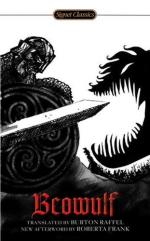|
This section contains 132 words (approx. 1 page at 400 words per page) |

|
Roman Empire fell, around 500 A.D., Germanic people of northern and central Europe moved south and west, creating new kingdoms. These migrating people included Germans, the Anglo-Saxons who settled in England, and Scandinavians, or residents of Sweden, Denmark, Norway, and Iceland. Since these Germanic groups were connected culturally, they held similar attitudes toward warfare and the ideal of the heroic figure. Thus Beowulf, although a Scandinavian hero, was recognized as heroic by the Anglo-Saxons as well. Based on historical persons who appear as characters in the epic poem, scholars have determined that the events took place in the sixth century A.D. While Beowulf himself is legendary, the world of warrior bands and small kingdoms throughout northern Europe that is the background of the poem is accurate.
|
This section contains 132 words (approx. 1 page at 400 words per page) |

|




